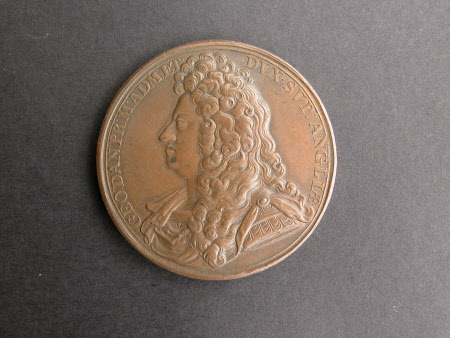Prince George of Denmark as Lord High Admiral
John Croker (1670 - 1741)
Category
Coins and medals
Date
1702
Materials
Copper
Measurements
415 mm (Diameter)
Place of origin
London
Order this imageCollection
Osterley Park and House, London
NT 773295
Summary
Copper, medal of Prince George of Denmark (1653-1708) as Lord High Admiral, by John Croker (1670-1741), struck London, United Kingdom, 1702. A copper medal by John Croker, featuring Queen Anne (1665-1714) on the obverse and, on the reverse, her consort Prince George of Denmark and Norway, Duke of Cumberland. On the obverse is a profile portrait of the Queen, facing left, her hair bound with a fillet, her gown fastened with a brooch at front. The Latin legend translates as ‘Anne by the Grace of God Queen of Great Britain, France and Ireland.’ On the reverse, a profile portrait of Prince George, also facing left and dressed in armour, and wearing a wig. The legend reads ‘George, Prince of Denmark, High Admiral and Commander-in-Chief of England.’
Full description
The medal is struck from two separate obverse dies. It was issued just a few weeks after Anne’s Coronation (see NT 773294) and celebrates the monarch’s granting to her husband, Prince George of Denmark, the title of Lord High Admiral of England and of Ireland, on 21 May 1702. She had already named George as Supreme Commander of land and sea forces, the other title referred to in the legend on the reverse of the medal. The post of Lord High Admiral of the Navy was a largely ceremonial one. Anne had married George, the son of King Frederik III of Denmark and Sophie Amalie of Brunswick-Lüneberg on 28 July 1683 in the Chapel Royal of St James’s Palace, London. The match, between members of two important Protestant royal families, was intended to help forge an Anglo-Danish alliance which would counterbalance the growing strength of Dutch naval power. It was therefore unpopular with William of Orange, the Dutch husband of Anne’s sister Mary, who much resented George. When he became King, William III went to lengths to exclude George from any active military role, however his dislike of his brother-in-law abated somewhat after Mary’s death in 1694, when Anne became the heir to the throne. Queen Anne was pregnant at least seventeen times, but almost all ended in miscarriages, still birth or the child’s rapid death. Anne and George’s only child to survive infancy, Prince William, Duke of Gloucester, was sickly throughout his short life and died in 1700 at the age of just 11, to the enormous grief of his parents. Prince George was easy-going and shunned the limelight; his wife’s uncle King Charles II famously said of him that "I have tried him drunk, and I have tried him sober and there is nothing in him." Unlike William, who demanded an equal role to his wife Mary, George was content to play the role of the dutiful consort. He and his wife were exceptionally close and fond of each other throughout their marriage; the Queen’s grief on George’s death in October 1708 was immeasurable. Jeremy Warren 2019
Provenance
Given to the National Trust in 1993 by George Child Villiers, 9th Earl of Jersey (1910-1998).
Marks and inscriptions
Obverse, legend: ANNA: D: G: MAG: BR: FRA: ET. HIB. REGINA. Reverse, legend: GEO: DAN: PR: M: ADM: ET. DVX. SVP: ANGLIAE.
Makers and roles
John Croker (1670 - 1741), medallist
References
Hawkins, Franks and Grueber 1885: Edward Hawkins, Augustus W. Franks and Herbert A. Grueber (eds.), Medallic Illustrations of the History of Great Britain and Ireland to the death of George II, 2 vols., London 1885, vol. II, p. 233, no. 14. Milford Haven 1919: Admiral the Marquess of Milford Haven, British Naval Medals, London 1919, p. 73, no. 118. Eimer 2010: Christopher Eimer, British Commemorative Medals and their Values, London 2010, p. 75, no. 392, pl. 46.
